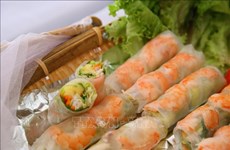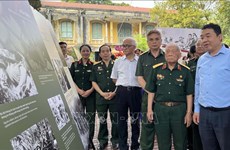Int’l Gong Festival to be held in Central Highlands
Forty troupes from both inside and
outside the country will attend the International Gong Festival, to be
held in the Central Highlands province of Gia Lai from Nov. 12-15.
Forty troupes from both inside and
outside the country will attend the International Gong Festival, to be
held in the Central Highlands province of Gia Lai from Nov. 12-15.
Besides 35 local troupes, artists from Cambodia , Indonesia , the Philippines , Laos and Myanmar will bring their “gongs” to the event.
The festival will take place in Pleiku City to celebrate the Central Highlands ’ gong culture, which was recognised by UNESCO as a unique part of the world’s heritage in December, 2005.
During the festival, many activities, including religious ceremonies accompanied by gong orchestras, contests, seminars and exhibitions will be held.
Artists and people from provincial ethnic groups, including the Jrai, Ybrom and Bana will take part in rain worship and New Year ceremonies. The performances will be held in the city’s parks and tourism areas.
Seminars on preserving gong music and developing tourism will be directed at business people.
A seminar calling for investment in 53 projects in Gia Lai will also taken place.
Two exhibitions will display photos, artifacts and bonsai from Central Highlands ethnic groups.
In anticipation of the festival, a three-month show of French documentary photos of the Central Highlands Gong music opened at the Vietnam Museum of Ethnology in Hanoi on November 6.
Ninety photos have been selected from French archives for the exhibition with most of them taken during the period of 1930s-1960s.
Gong music is a deeply rooted part of culture in most East and South-East Asian countries.
Gia Lai and other Central Highlands provinces plan to conduct gong-playing classes for young ethnic people and encourage the old to teach them.
Vietnam gongs consist of two main types, “cong” and “chieng”. “Cong” has a knob in the middle, while “chieng” has none. “Cong” makes deep bass sounds, but melodies have to be coaxed out of “chieng”./.
Besides 35 local troupes, artists from Cambodia , Indonesia , the Philippines , Laos and Myanmar will bring their “gongs” to the event.
The festival will take place in Pleiku City to celebrate the Central Highlands ’ gong culture, which was recognised by UNESCO as a unique part of the world’s heritage in December, 2005.
During the festival, many activities, including religious ceremonies accompanied by gong orchestras, contests, seminars and exhibitions will be held.
Artists and people from provincial ethnic groups, including the Jrai, Ybrom and Bana will take part in rain worship and New Year ceremonies. The performances will be held in the city’s parks and tourism areas.
Seminars on preserving gong music and developing tourism will be directed at business people.
A seminar calling for investment in 53 projects in Gia Lai will also taken place.
Two exhibitions will display photos, artifacts and bonsai from Central Highlands ethnic groups.
In anticipation of the festival, a three-month show of French documentary photos of the Central Highlands Gong music opened at the Vietnam Museum of Ethnology in Hanoi on November 6.
Ninety photos have been selected from French archives for the exhibition with most of them taken during the period of 1930s-1960s.
Gong music is a deeply rooted part of culture in most East and South-East Asian countries.
Gia Lai and other Central Highlands provinces plan to conduct gong-playing classes for young ethnic people and encourage the old to teach them.
Vietnam gongs consist of two main types, “cong” and “chieng”. “Cong” has a knob in the middle, while “chieng” has none. “Cong” makes deep bass sounds, but melodies have to be coaxed out of “chieng”./.













